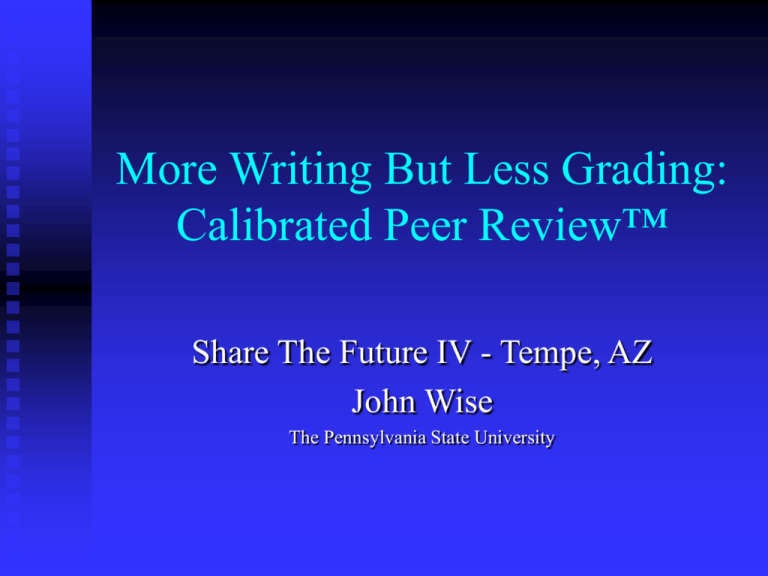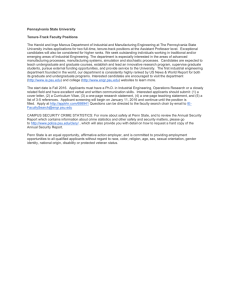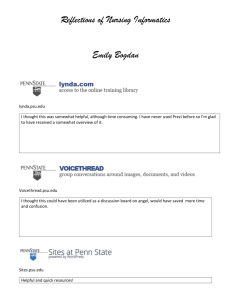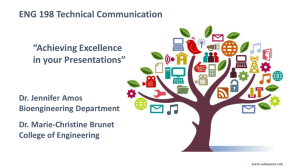Calibrated Peer Review
advertisement

More Writing But Less Grading: Calibrated Peer Review™ Share The Future IV - Tempe, AZ John Wise The Pennsylvania State University Penn State’s Engineering Instructional Services College of Engineering, University Park PA Associate Dean for Undergraduate Studies, Robert Pangborn Support and Training for Faculty and Teaching Assistants Engineering Instructional Services eis@engr.psu.edu Review of Bloom’s Taxonomy Knowledge Comprehension Application Analysis Synthesis Evaluation Bloom (1956) Taxonomy of educational objectives: the classification of educational goals Engineering Instructional Services eis@engr.psu.edu Problem Statement Large Classes in Particular: Predominantly Lecture Multiple Choice / “Scantron” Grading Feedback and Writing Difficult All Classes Student “Final” Papers Often First Drafts Product vs. Process Orientation Concept Misunderstandings Engineering Instructional Services eis@engr.psu.edu History of Calibrated Peer Review (CPR) Large Molecular Science Sections @ UCLA Science-Based Model Research, Write, Peer Review Now Can Serve Any Discipline and Educational Level Engineering Instructional Services eis@engr.psu.edu How It Works Create (or Select) Assignment Set Timing and Standards Manage Assignments Review Results Engineering Instructional Services eis@engr.psu.edu Create Assignment Choose Source Define Writing Assignment Write Exemplar Write Moderate / Poor Examples Generate Style and Content Questions Assess Own Documents for Calibration (sample) Engineering Instructional Services eis@engr.psu.edu Set Timing and Standards Control Over Text Entry Times Control Over Calibration Standards Control Over Scoring Scheme Engineering Instructional Services eis@engr.psu.edu Scoring Template: High Difficulty Calibrations To master each calibration students must: •Answer 3.0 of 4 (75%) STYLE questions correctly, and •Answer 5.3 of 7 (75%) CONTENT questions correctly, and •NOT deviate by more than 2.0 points from the RATING of a calibration text Reviews To master reviews students must: •NOT deviate by more than 2.0 points from the AVERAGE RATING of the reviewed text Self-Assessment To master self-assessment students must: •NOT deviate by more than 1.0 points from the AVERAGE RATING of their text to receive full credit, or •NOT deviate by more than 2.0 points from the AVERAGE RATING of their text to receive half credit Directions: Enter the points you want associated with each assignment stage. All points must sum to 100. Each point total can range from 0 to 100. 1.Text quality: XX points 2. Calibrations: XX points over 3 Calibrations 3. Reviews: XX points over 3 Reviews 4. Selfassessment: XX points TOTAL: must sum to 100 points Management Student Reminders Special Requests Late Submissions Technical Difficulties Engineering Instructional Services eis@engr.psu.edu Review Results Scan Student Results Identify “Problem” Scores Ability to Randomly Review Some or All Student Submissions Can also participate AS a student! Engineering Instructional Services eis@engr.psu.edu Student Name Reviewer Competency Index (RCI) (1-6) Complete Overall Grade Text Score (Out of 100) (Out of 10) [name] 91.81 7.27 6 finished [name] 94 8 6 finished [name] 91 7 5 finished Engineering Instructional Services eis@engr.psu.edu Student Point of View Review Materials Write Calibrate Review three examples, compared to professor Review 3 Random Peers Review Self Engineering Instructional Services eis@engr.psu.edu Calibrated Peer Review ™ (CPR) Available from UCLA http://cpr.molsci.ucla.edu Contact me for sample assignment jwise@engr.psu.edu 814-865-4020 Contact UCLA regarding traveling workshops Engineering Instructional Services eis@engr.psu.edu More Writing But Less Grading: Calibrated Peer Review™ Share The Future IV - Tempe, AZ John Wise The Pennsylvania State University





